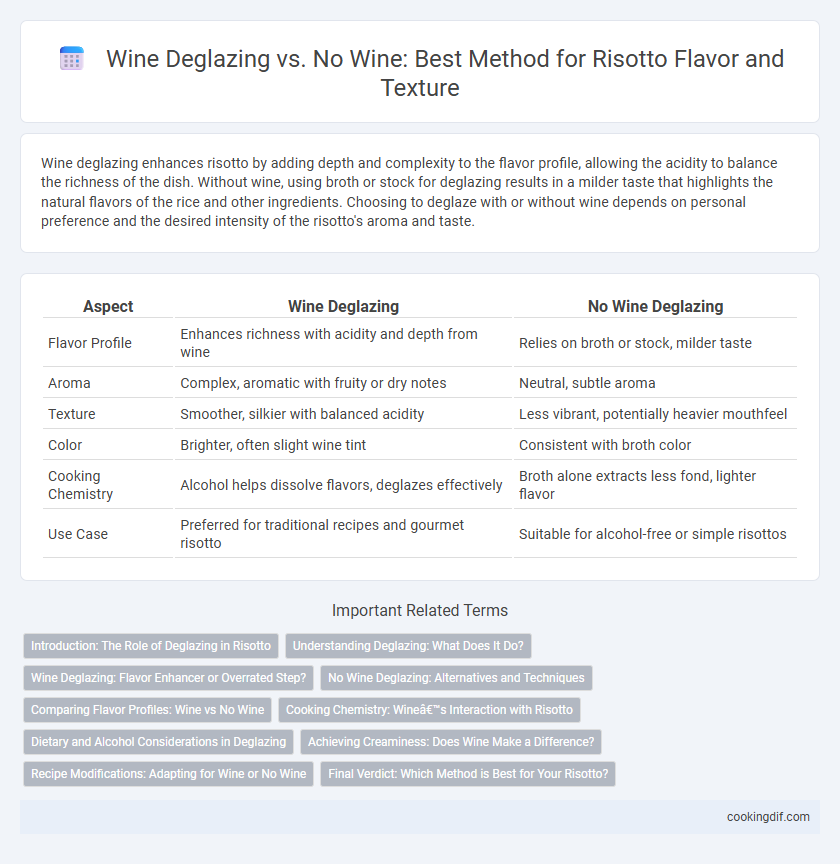Wine deglazing enhances risotto by adding depth and complexity to the flavor profile, allowing the acidity to balance the richness of the dish. Without wine, using broth or stock for deglazing results in a milder taste that highlights the natural flavors of the rice and other ingredients. Choosing to deglaze with or without wine depends on personal preference and the desired intensity of the risotto's aroma and taste.
Table of Comparison
| Aspect | Wine Deglazing | No Wine Deglazing |
|---|---|---|
| Flavor Profile | Enhances richness with acidity and depth from wine | Relies on broth or stock, milder taste |
| Aroma | Complex, aromatic with fruity or dry notes | Neutral, subtle aroma |
| Texture | Smoother, silkier with balanced acidity | Less vibrant, potentially heavier mouthfeel |
| Color | Brighter, often slight wine tint | Consistent with broth color |
| Cooking Chemistry | Alcohol helps dissolve flavors, deglazes effectively | Broth alone extracts less fond, lighter flavor |
| Use Case | Preferred for traditional recipes and gourmet risotto | Suitable for alcohol-free or simple risottos |
Introduction: The Role of Deglazing in Risotto
Deglazing plays a crucial role in risotto by lifting caramelized flavors from the pan, enriching the dish's depth and complexity. Wine deglazing introduces acidity and aromatic notes that balance the richness of the rice and broth, enhancing the overall flavor profile. Using broth or stock instead of wine allows for a more neutral base, focusing on the natural creaminess and texture of the risotto without added acidity.
Understanding Deglazing: What Does It Do?
Deglazing enhances risotto by lifting flavorful browned bits, or fond, from the pan, which intensifies the dish's depth and complexity. Using wine for deglazing adds acidity and nuanced fruity notes that balance the creaminess of the rice, while deglazing without wine relies on broth or stock to impart a milder, savory richness. Understanding how deglazing functions helps achieve optimal flavor extraction and a well-rounded risotto.
Wine Deglazing: Flavor Enhancer or Overrated Step?
Wine deglazing infuses risotto with complex acidity and depth, enhancing the subtle flavors of Arborio rice and broth. The alcohol in wine evaporates during cooking, leaving behind concentrated fruity and floral notes that balance the dish's creaminess. Skipping wine may result in a less nuanced flavor profile, but high-quality stock can partially compensate for the absence of this classic step.
No Wine Deglazing: Alternatives and Techniques
No wine deglazing alternatives include broth, stock, vinegar, or citrus juice, which effectively lift fond and enhance risotto's depth. Using warm vegetable or chicken broth maintains moisture while adding umami, crucial for a creamy texture. Techniques such as gradually incorporating the liquid allow starch release from rice, ensuring rich flavor development without alcohol.
Comparing Flavor Profiles: Wine vs No Wine
Wine deglazing in risotto introduces complex acidity and fruity notes that enhance the dish's depth and balance the creamy texture. Without wine, using broth or stock for deglazing creates a milder, more straightforward flavor that highlights the natural taste of the rice and other ingredients. The choice between wine and no wine significantly affects the risotto's aromatic profile, with wine providing a richer, more layered taste experience.
Cooking Chemistry: Wine’s Interaction with Risotto
Wine deglazing in risotto releases acidic compounds that enhance the starch molecules from Arborio rice, creating a creamier texture by breaking down amylopectin more effectively than water alone. The alcohol in wine also acts as a solvent, dissolving flavor compounds from the sauteed onions and rice, intensifying the dish's depth and aroma. Without wine, water or broth deglazing lacks these acidic and aromatic properties, resulting in a milder flavor profile and less pronounced starch gelatinization.
Dietary and Alcohol Considerations in Deglazing
Wine deglazing in risotto imparts depth and complexity but introduces alcohol content that may concern individuals with dietary restrictions or alcohol sensitivities. Using broth or vegetable stock as an alternative ensures a flavorful base while maintaining an alcohol-free dish suitable for children, pregnant individuals, and those abstaining from alcohol. Selecting deglazing liquids carefully supports inclusive dietary needs without compromising the risotto's creamy texture and rich taste.
Achieving Creaminess: Does Wine Make a Difference?
Wine deglazing enhances risotto by introducing acidity that balances the starch release, contributing to a creamier texture compared to using broth alone. The alcohol in wine helps dissolve flavorful compounds in the rice while its dryness intensifies the dish's savory notes, promoting a rich mouthfeel. Skipping wine for broth-only deglazing yields a milder creaminess, often requiring extra stirring or fat like butter to achieve similar results.
Recipe Modifications: Adapting for Wine or No Wine
Adapting risotto recipes for wine deglazing involves balancing acidity and depth by reducing dry white wine after sauteing the onions to enhance flavor complexity. For no-wine variations, substitute with a combination of broth and a splash of lemon juice or apple cider vinegar to maintain the necessary acidity and brightness without overpowering the dish. Adjust seasoning and liquid ratios carefully to ensure the risotto achieves a creamy texture and balanced taste profile regardless of wine usage.
Final Verdict: Which Method is Best for Your Risotto?
Wine deglazing enhances risotto by adding acidity and complex flavor notes that elevate the dish's depth. Skipping wine results in a simpler, milder flavor, relying more heavily on broth and seasoning for taste. Choosing wine for deglazing suits those seeking a richer, aromatic risotto, while omitting it appeals to preferences for a cleaner, more straightforward profile.
Wine Deglazing vs No Wine for deglazing Infographic

 cookingdif.com
cookingdif.com